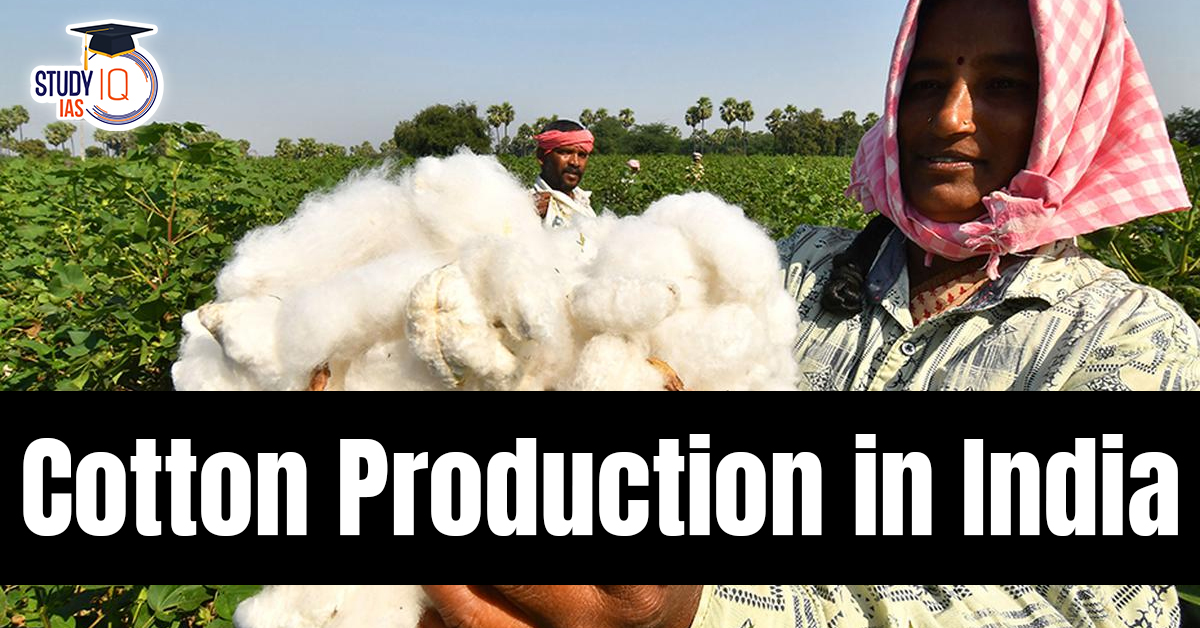Table of Contents
Context: India’s cotton production peaked with Bt cotton adoption (2002-2014) but in recent years it declined. India’s cotton output in the 2024-25 has declined to 294 lakh bales. It is the lowest since 2008-09 (290 lakh bales).
Cotton Production in India Background
Cotton is a major cash crop and a key raw material for the textile sector, supporting millions of farmers and workers. Check here Cotton Production in India from the Pre-2002 Period till today:
Pre-2002 Period
- India was a net importer of cotton with low productivity.
- Cotton production was reliant on traditional hybrids like:
- H-4 (first hybrid, 1970)
- Varalaxmi (first inter-specific hybrid, 1972)
- LSS (Labh Singh Selection) (1933)
2002-2014: Cotton Boom Due to Bt Cotton
- The introduction of genetically modified (GM) Bt cotton hybrids in 2002-03 transformed production.
- Bollgard-II technology (2006) further enhanced yield by providing protection from multiple pests (American bollworm, cotton leafworm).
- Cotton production tripled from 6 million bales (2002-03) to 39.8 million bales (2013-14).
- Lint yield rose from 127 kg/hectare (1970-71) to 566 kg/hectare (2013-14).
- India became the world’s largest producer (2015-16) and second-largest exporter (2011-12).
2014 Onwards: Production Decline
- Cotton production declined to an average of 8 million bales over the last five years.
- In 2024-25, production is projected at 5 million bales — the lowest since 2008-09.
- Lint yield dropped to sub-450 kg/hectare.
- Imports (3 million bales) are now surpassing exports (1.7 million bales).
|
Fact |
| Lint yield refers to the amount of clean, usable cotton fibers obtained from harvested cotton after removing the seeds and other impurities. It is usually measured in kilograms per hectare (kg/ha). |
Current Status of Cotton Production in India and Import-Export
- Cotton imports increased from $518.4 million (2023-24) to $1,040.4 million (2024-25).
- Cotton exports fell from $729.4 million (2023-24) to $660.5 million (2024-25).
- India now relies on cotton imports from the US, Brazil, Australia, and Egypt.
Use code “BLOG“ to Avail of “20% OFF“ Applicable on All Courses Including Books & Test Series
About Cotton
- Cotton is a kharif crop. It is grown mainly for its fibre (used in textiles) and seeds (used for oil and fodder).
- It is also called “White Gold” because of its economic importance to farmers and the textile industry.
- India is the largest producer of cotton globally, it accounts for 23% of total global cotton production.
- Major Cotton Producing States in India: (1) Gujarat (2) Maharashtra (3) Telangana
Ideal Conditions for Cotton Cultivation 🌦️
- A warm, dry climate with uniformly high temperatures (21°C to 30°C)
- Frost-free period of at least 200 days
- Moderate rainfall (50-100 cm).
Why is Cotton Production Declining in India?
- Policy Paralysis on GM Crops: After a successful Bt cotton rollout, approval for new GM technologies stalled.
- Existing Bt cotton (with cry1Ac and cry2Ab genes) is now ineffective.
- New GM hybrids developed by Indian companies are stuck in regulatory trials.
- No GM crop has been commercialised since 2006 due to opposition and long approval processes.
- Eg., Since Bollgard-II in 2006, no new GM technology for cotton has been approved.
- Emergence of Pink Bollworm (PBW) Infestation: Pink bollworm infestations emerged in central-western and southern regions in 2014 and spread to northern regions in 2018.
- The lack of new pest-resistant GM hybrids worsened the damage.
- PBW is a pest whose larvae damage cotton bolls (fruits), destroying seeds and lint (cotton fibre).
- It has developed resistance to Bt cotton (GM variety used in India).
- Regulatory and Judicial Hurdles: Regulatory bodies blocked field trials of GM crops under the Environment Protection Act (1986).
- Courts interfered in technical matters, delaying new technology approvals.
- Hybrid mustard (developed by Delhi University) remains unapproved despite successful trials and safety data.
- High Production Costs and Falling Yields: Rising input costs and stagnant yields made cotton farming less profitable.
- Farmers lack access to updated pest-resistant and climate-adaptive varieties.
- Global Pressure and Trade Barriers: The US and Brazil are pushing for the removal of the 11% import duty on cotton.
- India’s decision to allow imports of GM soya meal and cake in 2021 may lead to similar demands for GM corn and cotton imports.
- Climate Change: Erratic rainfall, unseasonal rains and long dry spells affect cotton growth.
- Low Profitability: Rising input costs (seeds, fertilizers, pesticides).
- Monocropping & Poor Crop Rotation: Continuous cotton cropping without rotation → soil nutrient depletion and pest buildup.
What Needs to Be Done?
- Revive Approval Process for GM Crops: Fast-track the approval of new GM technologies like Bollgard-III and indigenous pest-resistant varieties.
- Allow field trials of genetically modified mustard and cotton hybrids.
- Strengthen Pest Control Measures: Develop integrated pest management (IPM) strategies.
- Encourage the breeding of pest-resistant, high-yielding cotton varieties.
- Policy Clarity on GM Crops: Establish a transparent, science-based regulatory framework for GM crop approvals.
- Limit political and activist interference in scientific evaluation processes.
- Support Farmers with Technology and Inputs: Ensure access to high-quality seeds and affordable inputs.
- Educate farmers on sustainable farming practices and pest control.
- Protect Domestic Cotton from Import Competition: Maintain strategic import duties to protect domestic production.
- Negotiate trade terms with major exporters like the US and Brazil.
- Enhance Research and Development: Invest in agricultural research institutions for developing climate-resilient and pest-resistant cotton varieties.
- Encourage public-private partnerships in cottonseed research and production.
| UPSC PYQ |
“The crop is subtropical in nature. A hard frost is injurious to it. It requires at least 210 frost-free days and 50 to 100 centimetres of rainfall for its growth. A light well-drained soil capable of retaining moisture is ideally suited for the cultivation of the crop.” Which one of the following is that crop? (2020)
Answer: A |


 Antibiotic Pollution in Rivers, Reasons ...
Antibiotic Pollution in Rivers, Reasons ...
 National Environmental Engineering Resea...
National Environmental Engineering Resea...
 Tiger Reserves in Madhya Pradesh List an...
Tiger Reserves in Madhya Pradesh List an...





















